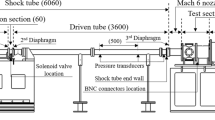Abstract
This is a report on the calibration tests and the determination of the response characteristics of a thrust anemometer designed to measure the three-dimensional instantaneous wind vector. Static tests determined the instrument calibration constants and checked the linearity of the system. Dynamic tests performed in a wind tunnel established that the ‘V 2’ drag law applies to the sensing system. The wind-tunnel tests also determined the range of angles for which the anemometer was capable of resolving the vector wind. Finally, the amplitude and phase frequency response characteristics were measured. It was found that knowledge of the latter was important in studying turbulence spectra and cross spectra. Some preliminary results from a recent field program are presented which document the need for correcting the amplitude and phase responses.
Similar content being viewed by others
References
Adelfang, S. I.: 1969, ‘Measurements of Atmospheric Turbulence a Few Meters Above the Sea Surface with a Three-Component Thrust Anemometer’, Report TR-69-3, Geophysical Sciences Laboratory, and Ph.D. dissertation, New York University, New York.
Clancy, M. P.: 1970, ‘Sea Surface Wind Stress: Theoretical Calculations Compared with Direct Measurements’, Report TR-70-6, Geophysical Science Laboratory, and MS thesis, New York University, New York.
Doe, L. A. E.: 1963, ‘A Three Component Thrust Anemometer for Studies of Vertical Transports Above the Sea Surface’, Report BIO 63-1, Bedford Institute of Oceanography, Dartmouth, N.S.
Earle, M. D.: 1971, ‘A Three Component Drag Probe for the Measurement of Ocean Wave Orbital Velocities and Turbulent Water Velocity Fluctuations’, Ph.D. dissertation, Oregon State University, Corvallis, Oregon.
Hinze, J. O.: 1959,Turbulence — An Introduction to its Mechanism and Theory, McGraw Hill Book Company Inc., New York.
Lappe, U. O., Kirwan, A. D., Jr., and Adelfang, S. I.: 1967, ‘Some Aspects of Boundary-Layer Turbulence over Land and Ocean’,Phys. Fluids 10, 206–208.
McNally, G. J.: 1970, ‘A Thrust Anemometer for the Measurement of the Turbulent Wind Vector’, Report TR-70-1, Geophysical Sciences Laboratory, and MS thesis, New York University, New York.
Norwood, M. H., Cariffe, A. E., and Odszewski, V. E.: 1966, ‘Drag Force Solid State Anemometer and Vane’,J. Appl. Meteorol. 5, 887–892.
Reed, W. H. and Lynch, J. W.: 1963, ‘A Simple Fast Response Anemometer’,J. Appl. Meteorol. 2, 412–416.
Schlichting, H.: 1960,Boundary-Layer Theory, McGraw Hill Book Co., Inc. New York, pp. 15–16.
Smith, S. D.: 1967, ‘Thrust-Anemometer Measurements of Wind-Velocity Spectra and of Reynolds Stress over a Coastal Inlet’,J. Marine Res. 25, 239–262.
Smith, S. D.: 1970, ‘Thrust-Anemometer Measurements of Wind Turbulence, Reynolds Stress, and Drag Coefficient over the Sea’,J. Geophys. Res. 75, 6758–6770.
Author information
Authors and Affiliations
Rights and permissions
About this article
Cite this article
Kirwan, A.D., McNally, G. & Mehr, E. Response characteristics of a three-dimensional thrust anemometer. Boundary-Layer Meteorol 8, 365–381 (1975). https://doi.org/10.1007/BF02153558
Received:
Issue Date:
DOI: https://doi.org/10.1007/BF02153558




